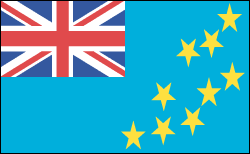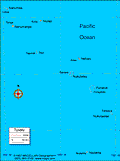Tuvalu (original) (raw)
Tuvalu | Facts & Information
- Tuvalu Profile
- History
- News and Current Events
Infoplease has everything you need to know about Tuvalu. Check out our country profile, full of essential information about Tuvalu's geography, history, government, economy, population, culture, religion and languages. If that's not enough, click over to our collection of world maps and flags.

Facts & Figures
- Sovereign: Queen Elizabeth II (1952)
Governor-General: Iakoba Italeli (2010)
Prime Minister: Enele Sopoaga (2013)
Total area: 10 sq mi (26 sq km)
Population (2014 est.): 10,782 (growth rate: 0.8%); birth rate: 23.74/1000; infant mortality rate: 31.69/1000; life expectancy: 65.81; density per sq mi: 1,142
Capital and largest city (2011 est.): Funafuti, 5,000
Monetary unit: Australian dollar
Current government officials
Languages: Tuvaluan, English, Samoan, Kiribati (on the island of Nui)
Ethnicity/race: Polynesian 96%, Micronesian 4%
Religions: Church of Tuvalu (Congregationalist) 97%, Seventh-Day Adventist 1.4%, Baha'i 1%, other 0.6%
Literacy rate: n.a.
Economic summary: GDP/PPP (2013 est.): 40million;percapita40 million; per capita 40million;percapita3,500 (2013 est.). Real growth rate: 1.1% (2013 est.). Inflation: 3.8% (2006 est.). Unemployment: n.a. Arable land: 0%. Agriculture: coconuts; fish. Labor force: 3,615 (2004 est.); people make a living mainly through exploitation of the sea, reefs, and atolls and through overseas remittances (mostly from workers in the phosphate industry and sailors). Industries: fishing, tourism, copra. Natural resource: fish. Exports: 600,000(2010est.):copra,fish.∗∗Imports:∗∗600,000 (2010 est.): copra, fish. Imports: 600,000(2010est.):copra,fish.∗∗Imports:∗∗16.5 million (2010 est.): food, animals, mineral fuels, machinery, manufactured goods. Major trading partners: Germany, Fiji, Italy, UK, Poland, Japan, Australia, China, New Zealand (2004).
Member of Commonwealth of Nations
Communications: Telephones: main lines in use: 1,450 (2012); mobile cellular: 2,800 (2012). Radio broadcast stations: AM 1, FM 0, shortwave 0 (2009). Radios: 4,000 (1997). Television broadcast stations: 0 (1997). Televisions: 800. Internet Service Providers (ISPs): 145,158 (2012). Internet users: 4,200 (2008)
Transportation: Railways: 0 km. Highways: total: 8 km (2011 est.); paved: 8 km; unpaved: 0 km. Ports and harbors: Funafuti. Airports: 1 (2013).
International disputes: none.
Major sources and definitions
Geography
Tuvalu consists of nine small islands scattered over 500,000 sq mi of the western Pacific, just south of the equator. The islands include Niulakita, Nukulaelae, Funafuti, Nukufetau, Vaitupu, Nui, Niutao, Nanumaga (Nanumanga), and Nanumea.
Government
Constitutional monarchy with a parliamentary democracy.
History
Formerly the Ellice Islands, Tuvalu's first Polynesian settlers were probably Samoans or Tongans. The Ellice Islands became a British protectorate in 1892 and were annexed by Britain in 1915–1916 as part of the Gilbert and Ellice Islands Colony. The Ellice Islands were separated from the Gilberts in 1975, given home rule, and renamed Tuvalu. Full independence was granted on Sept. 30, 1978, but Tuvalu remained part of the Commonwealth. In 1979, the U.S. gave Tuvalu four islands that had been U.S. territory.
In 1997, the government adopted a strong stance on the need to control emissions of greenhouse gases in order to ensure the survival of low-lying island nations, which are threatened by rising sea levels—Tuvalu's highest point is just 16 ft above sea level. In 2000, Tuvalu became a member of the United Nations. Tuvalu reportedly makes millions of dollars each year by leasing its highly marketable .tv Internet domain.
One of the Smallest Countries Gets Smaller
Tuvalu, one of the smallest countries in the world, has gotten smaller, according to scientists. Already just about a third of the size of Manhattan, with less than 12,000 people inhabiting it, Tuvalu's lowest point was just above sea level in 2012.
The National Research Council in the United States predicted that by 2100 global sea levels would rise 55 inches due to climate change. If that prediction holds true, the rising sea levels could damage the country's coral roots and wipe out Tuvalu altogether. By 2012, there was already coastal erosion, a result of the rising sea level, excavation for construction, and extreme weather.
Sopoaga Becomes Prime Minister
On August 5, 2013, Enele Sopoaga was sworn in as the twelfth prime minister of Tuvalu. Sopoaga had been the leader of the opposition to former Prime Minister Willy Telavi. When Telavi was removed by Governor General Iakoba Italeli, Sopoaga became caretaker prime minister.
Earlier in the summer of 2013, Telvai had been removed as prime minister over allegations that he had attempted to break the country's constitution by planning to replace Governor General Italeli. After placed in the role as an interim prime minister, Sopoaga later won a vote to take over as prime minster.
See also Encyclopedia: Tuvalu .
U.S. State Dept. Country Notes: Tuvalu
